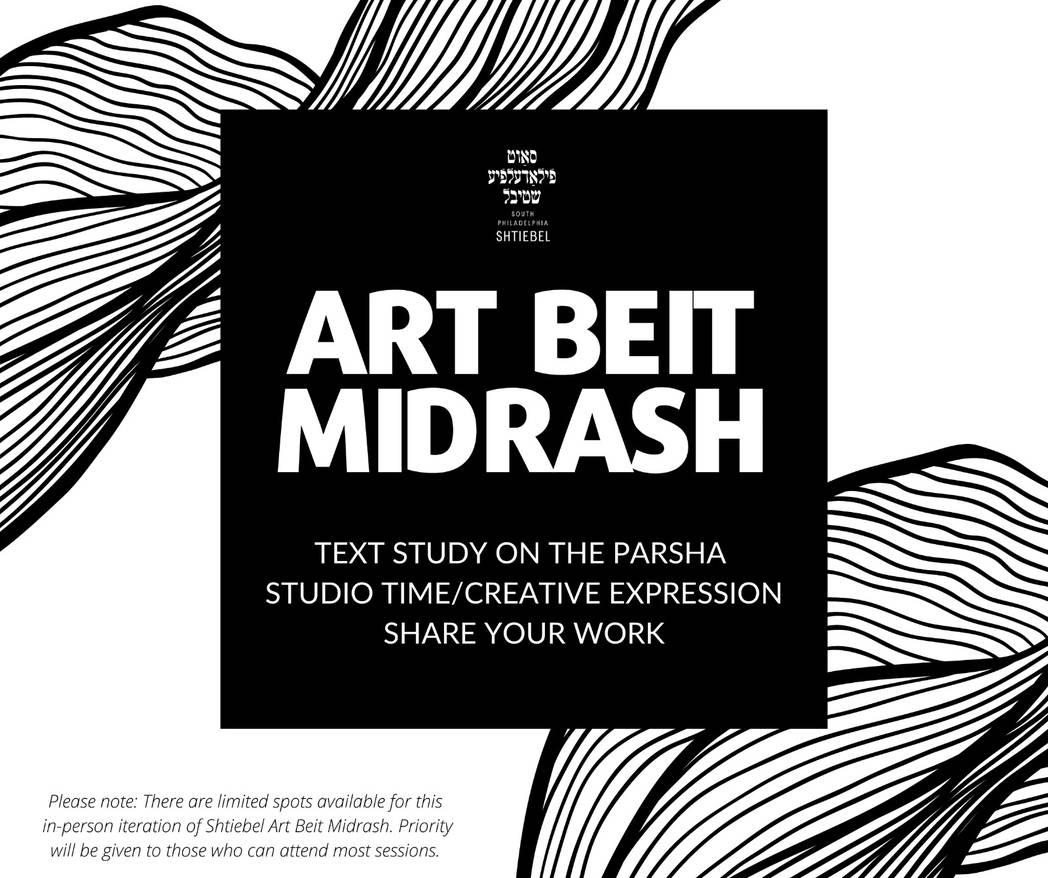Welcome to the South Philadelphia Shtiebel's Art Beit Midrash.
Each session begins with 10-15 minutes of facilitated text study related to the Parsha (weekly Torah portion) followed by 45-50 minutes of studio time/creative interpretation of the texts.
Take a look at the sources and questions below. What do you make of it?
Each session begins with 10-15 minutes of facilitated text study related to the Parsha (weekly Torah portion) followed by 45-50 minutes of studio time/creative interpretation of the texts.
Take a look at the sources and questions below. What do you make of it?
(א) וַיֹּ֤אמֶר יְהֹוָה֙ אֶל־מֹשֶׁ֣ה וְאֶֽל־אַהֲרֹ֔ן בְּאֶ֥רֶץ מִצְרַ֖יִם לֵאמֹֽר׃ (ב) הַחֹ֧דֶשׁ הַזֶּ֛ה לָכֶ֖ם רֹ֣אשׁ חֳדָשִׁ֑ים רִאשׁ֥וֹן הוּא֙ לָכֶ֔ם לְחׇדְשֵׁ֖י הַשָּׁנָֽה׃
(1) The LORD said to Moses and Aaron in the land of Egypt: (2) This month shall mark for you the beginning of the months; it shall be the first of the months of the year for you.
הזה. נִתְקַשָּׁה מֹשֶׁה עַל מוֹלַד הַלְּבָנָה, בְּאֵיזוֹ שִׁעוּר תֵּרָאֶה וְתִהְיֶה רְאוּיָה לְקַדֵּשׁ, וְהֶרְאָה לוֹ בְּאֶצְבַּע אֶת הַלְּבָנָה בָּרָקִיעַ וְאָמַר לוֹ כָּזֶה רְאֵה וְקַדֵּשׁ (שם). וְכֵיצַד הֶרְאָהוּ? וַהֲלֹא לֹא הָיָה נִדְבָּר עִמּוֹ אֶלָּא בַּיּוֹם? שֶׁנֶּ' "וַיְהִי בְּיוֹם דִּבֶּר ה'" (שמות ו'), "בְּיוֹם צַוֹּתוֹ" (ויקרא ז'), "מִן הַיּוֹם אֲשֶׁר צִוָּה ה' וָהָלְאָה" (במדבר ט"ו)? אֶלָּא סָמוּךְ לִשְׁקִיעַת הַחַמָּה נֶאֶמְרָה לוֹ פָרָשָׁה זוֹ וְהֶרְאָהוּ עִם חֲשֵׁכָה:
הזה THIS [STAGE OF RENEWAL] — Moses was in perplexity regarding the Molad of (the exact moment when begins) the new moon — how much of it must be visible before it is proper to consecrate it as new moon: He therefore pointed it out to him in the sky with the finger and said to him, “Behold it like this, and consecrate it” (i. e., when you see the moon in a stage of renewal similar to this which you now behold you may proclaim that a new month has begun). But how could He point it out to him, for did He not conserve with him only by day, as it is said, (Exodus 6:28) “And it came to pass on the day when the Lord spake [unto Moses]”; (Leviticus 7:38) “On the day when he commanded”; (Numbers 15:23) “From the day that the Lord commanded and henceforward”? But the explanation is: This chapter was spoken to him close to sunset and He pointed it out to him at nightfall (more lit., near darkness) (Mekhilta d'Rabbi Yishmael 12:2:1).
Study Questions:
- According to Rashi, what is the significance of the word "This" in verse two?
- Is there any significance to God's demonstrative act happening at sunset?
- Are there other elements of Jewish tradition or observance that involve pointing?
Art Prompts:
- Represent the moment God pointed out the new moon to Moses. What else is in the sky? How does Moses know what God is referring to?
- Think of another ritual time that you have observed or witnessed others observing (ex: Shabbat, Shemitah, High Holidays, bar/bat mitzvah, baby naming, etc). How would you represent it? If you'd like, draw an image that represents this ritual time with the title, "This is what [_____] looks like."
This next excerpt is from the Passover Hagaddah:
יָכוֹל מֵראשׁ חֹדֶשׁ? תַּלְמוּד לוֹמַר בַּיּוֹם הַהוּא. אִי בַּיּוֹם הַהוּא יָכוֹל מִבְּעוֹד יוֹם? תַּלְמוּד לוֹמַר בַּעֲבוּר זֶה – בַּעֲבוּר זֶה לֹא אָמַרְתִּי, אֶלָּא בְּשָׁעָה שֶׁיֵּשׁ מַצָּה וּמָרוֹר מֻנָּחִים לְפָנֶיךָ.
It could be from Rosh Chodesh [that one would have to discuss the Exodus. However] we learn [otherwise, since] it is stated, "on that day." If it is [written] "on that day," it could be from while it is still day [before the night of the fifteenth of Nissan. However] we learn [otherwise, since] it is stated, "for the sake of this." I didn't say 'for the sake of this' except [that it be observed] when [this] matsa and maror are resting in front of you [meaning, on the night of the fifteenth].
Let's take a look at Exodus 13:8:
(ו) שִׁבְעַ֥ת יָמִ֖ים תֹּאכַ֣ל מַצֹּ֑ת וּבַיּוֹם֙ הַשְּׁבִיעִ֔י חַ֖ג לַיהֹוָֽה׃ (ז) מַצּוֹת֙ יֵֽאָכֵ֔ל אֵ֖ת שִׁבְעַ֣ת הַיָּמִ֑ים וְלֹֽא־יֵרָאֶ֨ה לְךָ֜ חָמֵ֗ץ וְלֹֽא־יֵרָאֶ֥ה לְךָ֛ שְׂאֹ֖ר בְּכׇל־גְּבֻלֶֽךָ׃ (ח) וְהִגַּדְתָּ֣ לְבִנְךָ֔ בַּיּ֥וֹם הַה֖וּא לֵאמֹ֑ר בַּעֲב֣וּר זֶ֗ה עָשָׂ֤ה יְהֹוָה֙ לִ֔י בְּצֵאתִ֖י מִמִּצְרָֽיִם׃
(6) “Seven days you shall eat unleavened bread, and on the seventh day there shall be a festival of the LORD. (7) Throughout the seven days unleavened bread shall be eaten; no leavened bread shall be found with you, and no leaven shall be found in all your territory. (8) And you shall explain to your child on that day, ‘It is because of what the LORD did for me when I went free from Egypt.’
Study Questions:
- Is the intergenerational nature of the dialogue in verse 8 significant? Why or why not?
Art Prompts:
- What objects do you expect to find on a Passover seder plate?
- Imagine sharing the narrative of your life or some significant moment with someone, and imagine you could choose 2 or 3 objects as props. What would you choose? How would these props be part of the story? Does this feel like a natural or unnatural way to tell a story?
- Are there other texts, images, and/or questions that come to mind from this study? How are they in dialogue with each other?




